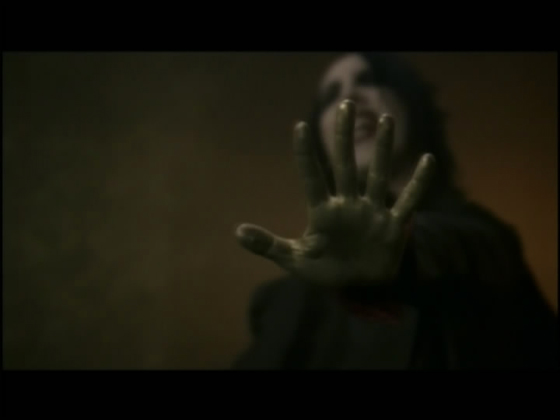the NachtKabarett

All Writing & Content © Nick Kushner Unless Noted Otherwise
Sacrifice involved the sprinkling of the blood of the sacrificed animal, or human, upon the stones of the altar; alternately the blood was dashed down at the base of the altar, but this was probably a later practice. It was magically important that the blood baptize the altar stones if the spirit of God was to be made to reside within the stones. Blood was believed to be the vehicle of the life force. Blood splashed upon the stones conveyed the life force of sacrifice, which rested in the blood, to God, who resided in the stones. The act of killing itself was not nearly so significant, magically, as the sprinkling of blood.Tetragrammaton by Donald Tyson. On the stone altar and sacrifice made by the 12 tribes of Israel, as ordered by Joshua after crossing the River Jordan.

Just as the name 'Marilyn Manson' is a dichotomy of opposing elements, the term 'Eat Me, Drink Me' is itself a union of opposites in the context of Alice in Wonderland. 'Eat Me', the cake, made Alice grow while 'Drink Me', the bottle, made her shrink. In other words, the album title can dually act as an extension of the black/white, good/evil dichotomy that Manson continually portrays.
'Eat Me, Drink Me' can be seen, to philosophize on a deeper level, as the union of expansion and contraction; dichotomy of opposites, Marilyn and Manson. An alchemical union which Jodorowsky himself will assimilate to the philosopher's stone.
 |
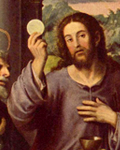 |
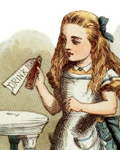 |
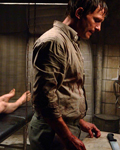 |
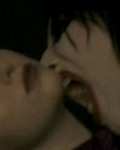 |
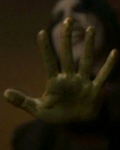 |
||||
Click thumbnails above for each connection tackled in the album. |
|||||||||
 'EAT ME, DRINK ME'. A romantic and newly inspired Manson with literal 'hearts in his eyes'.
'EAT ME, DRINK ME'. A romantic and newly inspired Manson with literal 'hearts in his eyes'. Abruptly in April 2007, following the revelation of the new album title, 'Eat Me, Drink Me', MarilynManson.com changed drastically from its previous "Celebritarian" theme to a new and surreal raw state. A new direction emerged in the events leading up to the album's release; the double cross became less prominent and has since been replaced with a new twisted heart icon (depicted in the album artwork and later revealed as being a new wrist tattoo in homage to Manson's reinvigorated creativity he attributes to Evan Rachel Wood; SPIN magazine June 2007, album liner notes included), and much of the more cryptic elements and imagery that had teased visitors for well over a year seemed to shift towards a more visceral, emotional & subjective examination of perhaps Manson's most difficult year yet. Immediately the conflict emerged in regard to Manson's previous intentions for Celebritarianism and this new example of new life bleeding and entwining itself within his art.
 Manson performing in Romania, July 1, 2007. In full view is the new twisted heart logo tattoo.
Manson performing in Romania, July 1, 2007. In full view is the new twisted heart logo tattoo. "This record is the best artistic thing that I could offer to represent Celebritarian ideology"'Red Carpet Grave' interview, MansonUSA. 2007.
Though this new direction appears at first to be a drastic departure from all that Manson had hinted at cultivating since the Against All Gods tour, many parallels and themes evocative of Celebritarianism have emerged in the album which has become his most personal artistic reflection to date.
 |
 |
| The Celebritarian Double Cross with detail of its subtle integration as made by the window frame on the cover of 'Eat Me, Drink Me' | |
Along with the above in which the Celebritarian Double Cross is subtly depicted on the cover of the album, Manson has also continuously worn his Double Cross Celebritarian Corporation ring, extending to even after this seemingly new shift in artistic direction emerged. It's reasonable to believe that Celebritarianism is a concept much larger and wider reaching than can be contained on just one album, as it is of course a theme which has been recurrently and explicitly illustrated by Manson since Holy Wood in 2000. 'Eat Me, Drink Me' instead is an example of Celebritarianism and is fully the powerful and cathartic art which is a personal statement, rather than just talking about doing so.
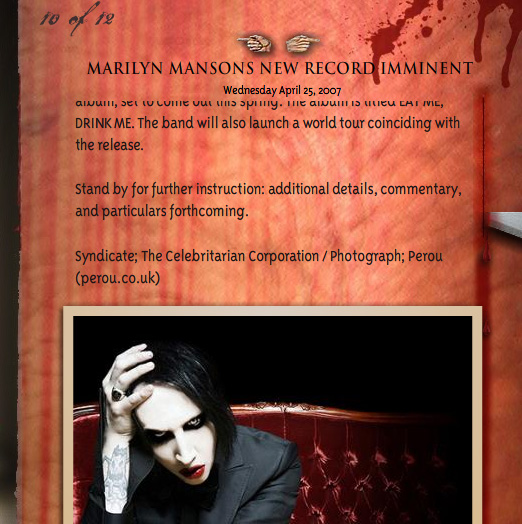 Likewise in reflecting the album as being a direct product of Manson's concept of Celebritarianism, rather than a complete departure as many were initially led to believe, the very first press release on 'Eat Me, Drink Me' that was posted on MarilynManson.com was listed as being syndicated by the mock agency which is none other than the Celebritarian Corporation.
Likewise in reflecting the album as being a direct product of Manson's concept of Celebritarianism, rather than a complete departure as many were initially led to believe, the very first press release on 'Eat Me, Drink Me' that was posted on MarilynManson.com was listed as being syndicated by the mock agency which is none other than the Celebritarian Corporation.The very title, 'Eat Me, Drink Me', represents a multidimensional group of themes, all of which are relevant to Celebritarianism. Four of the most prevalent concepts being the morbid and death-centered Christian theology, specifically Christ's sacrificial offering of his body for the world to devour which is present in the synoptic gospels and other writings contained within the Holy Bible; passages of text contained with Lewis Carroll's "Alice in Wonderland" and the infamous quote from which the album derives its name; the famous cannibalistic fantasy which was enacted in Rotenburg Germany by Armin Meiwes and Bernd Jürgen Armando Brandes; and lastly the romantic vampiric connection of "draining the life out of a woman" and Manson's full-on adoption of the role of Nosferatu which his critics have attempted to pigeonhole him into since the beginning.
'Eat Me, Drink Me' album title connections
collaborated between Nick Kushner and Brad Jaeger
One of the most prominent themes of the new album's title can be taken from the Eucharist, also known as the time of Thanksgiving, in which Jesus gave his disciples the instruction to eat of his flesh and drink of his blood. This is precisely where the concept of Manson's Celebritarianism originates from; that is, in the view presented by Manson of Christ being the first celebrity and the crucifix being the first piece of merchandise, Celebritarianism is the worship of death and celebrity and is thereby, as the word itself implies, the consuming and devouring of celebrity as taken example from the symbology of the Eucharist.
 'Eat Me' ; Manson as the sacrificial body of Christ, the main course of his own Last Supper. Still frame from the 'Disposable Teens' video.
'Eat Me' ; Manson as the sacrificial body of Christ, the main course of his own Last Supper. Still frame from the 'Disposable Teens' video.There are several accounts of the Eucharist located within the body of the New Testament, including accounts contained within all of the synoptic gospels (Mark, Luke & Matthew). Below is an account by Mark, of which is also mirrored in the writings of Luke and Matthew:
And as they did eat, Jesus took bread, and blessed, and brake it, and gave to them, and said, Take, eat: this is my body. / And he took the cup, and when he had given thanks, he gave it to them: and they all drank of it. / And he said unto them, This is my blood of the new testament, which is shed for many.Mark 14:22-24 KJV
And he took bread, and gave thanks, and brake it, and gave unto them, saying, This is my body which is given for you: this do in remembrance of me. / Likewise also the cup after supper, saying, This cup is the new testament in my blood, which is shed for you.Luke 22:19-20 KJV
And as they were eating, Jesus took bread, and blessed it, and brake it, and gave it to the disciples, and said, Take, eat; this is my body. /And he took the cup, and gave thanks, and gave it to them, saying, Drink ye all of it; / For this is my blood of the new testament, which is shed for many for the remission of sins. /But I say unto you, I will not drink henceforth of this fruit of the vine, until that day when I drink it new with you in my Father's kingdom.Matthew 26:26-29 KJV
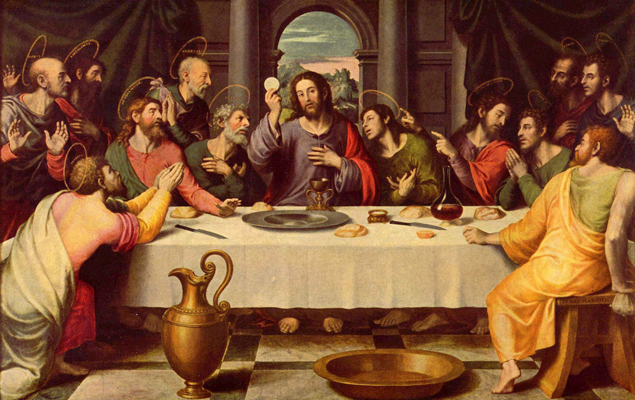 'The Last Supper' as seen by Juan de Juanes, 1560.
'The Last Supper' as seen by Juan de Juanes, 1560.There are also instructions contained within other texts of the New Testament, including the First Epistle to the Corinthians and the book of John:
And when he had given thanks, he brake it, and said, Take, eat: this is my body, which is broken for you: this do in remembrance of me. / After the same manner also he took the cup, when he had supped, saying, this cup is the new testament in my blood: this do ye, as oft as ye drink it, in remembrance of me. / For as often as ye eat this bread, and drink this cup, ye do shew the Lord's death till he come.I Corinthians 11:24-26 KJV
I am the living bread which came down from heaven: if any man eat of this bread, he shall live for ever: and the bread that I will give is my flesh, which I will give for the life of the world. / The Jews therefore strove among themselves, saying, How can this man give us his flesh to eat? / Then Jesus said unto them, Verily, verily, I say unto you, Except ye eat the flesh of the Son of man, and drink his blood, ye have no life in you. / Whoso eateth my flesh, and drinketh my blood, hath eternal life; and I will raise him up at the last day. / For my flesh is meat indeed, and my blood is drink indeed. /He that eateth my flesh, and drinketh my blood, dwelleth in me, and I in him. / As the living Father hath sent me, and I live by the Father: so he that eateth me, even he shall live by me. / This is that bread which came down from heaven: not as your fathers did eat manna, and are dead: he that eateth of this bread shall live for ever.John 6:51-58 KJV
What connects all of these writings is the concept that salvation and eternal life is granted to all those who give into the sacrificial rite of devouring Christ's flesh and quenching their thirst on his blood.
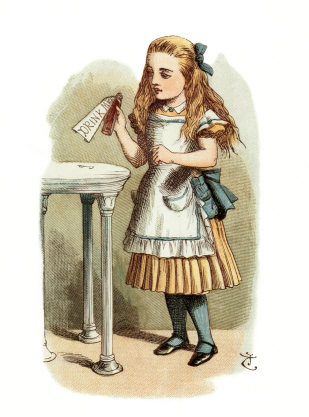 An illustration from Lewis Carroll's 'Alice In Wonderland' by John Tenniel.
An illustration from Lewis Carroll's 'Alice In Wonderland' by John Tenniel.Notoriously adopted in popular culture by Jefferson Airplane as the rallying cry for the psychedelic generation of the 60's, as most are familiar with it, the following passages of Lewis Carroll's creation, "Alice in Wonderland" are of notable importance as the title "Eat Me, Drink Me" is quite literally taken verbatim from the instructions written on the cake and bottle respectively, along with Manson's numerous connections to Carroll via his production of Phantasmagoria: The Visions of Lewis Carroll, and Manson's fixation on both Carroll, and his intangible literary creation, Alice, created from the author's own fixation of a particular young girl:
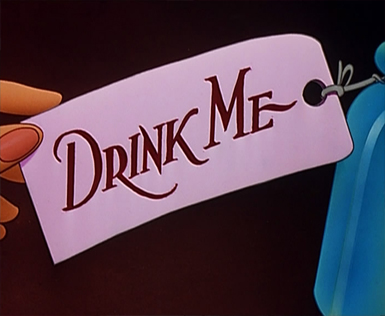 |
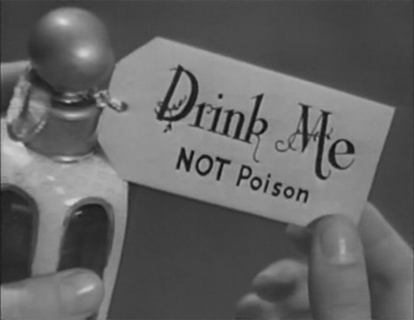 |
| Screen captures from the 1951 Disney animated 'Alice in Wonderland' and the 1933 live action filmic version | |
There seemed to be no use in waiting by the little door, so she went back to the table, half hoping she might find another key on it, or at any rate a book of rules for shutting people up like telescopes: this time she found a little bottle on it ("which certainly was not here before," said Alice), and tied round the neck of the bottle was a paper label, with the words "DRINK ME" beautifully printed on it in large letters.
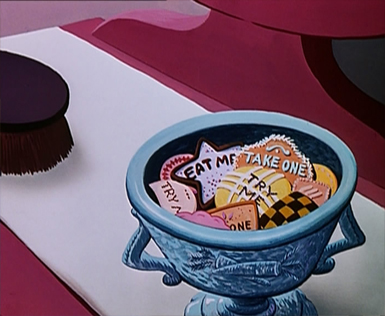 |
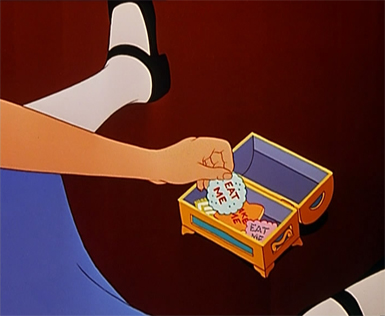 |
| Screen captures of the 'Eat Me' cookies from the 1951 Disney animated 'Alice in Wonderland' | |
Soon her eye fell on a little glass box that was lying under the table: she opened it, and found in it a very small cake, on which the words "EAT ME" were beautifully marked in currants. "Well, I'll eat it," said Alice, "and if it makes me grow larger, I can reach the key; and if it makes me grow smaller, I can creep under the door; so either way I'll get into the garden, and I don't care which happens!Alice's Adventures In Wonderland by Lewis Carrol
 |
 |
| Left ; Chocolates which were given out in UK to promote EAT ME, DRINK ME. Photo courtesy of Norsefire of Celebritarian.co.uk. Right ; 'Drink Me' from the 1903 film version of 'Alice in Wonderland'. | |
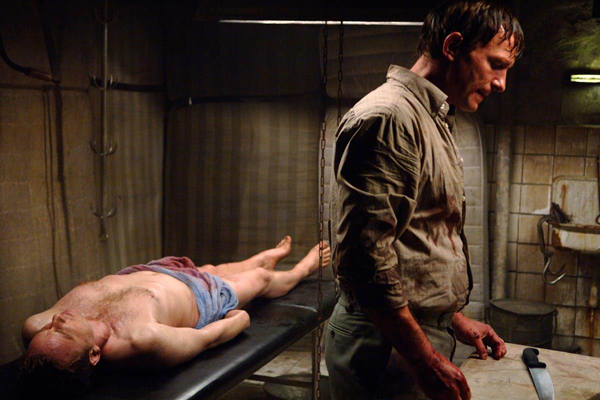 Scene from the 2005 movie Grimm Love (Rohtenburg), which narrates the story of the "Master Butcher" and his devoted victim.
Scene from the 2005 movie Grimm Love (Rohtenburg), which narrates the story of the "Master Butcher" and his devoted victim. In Rotenburg, Hessen, Germany, March 2001, two men both in their 40's, Armin Meiwes and Bernd Jürgen Armando Brandes, met together after Brandes had responded to an online post by Armin Meiwes, in which Meiwes wrote, "Looking for a well built 18 to 30 year old to be slaughtered", which he signed as "The Master Butcher".
Brandes and Meiwes met, dismembered Brandes' penis, and consumed it together. It is reported that afterwards Brandes voluntarily consented to his own death, and was killed by Meiwes, who then ate his remains. Originally sentenced to an 8½ year sentence for manslaughter, Meiwes was later charged with murder, and resentenced, this time to life imprisonment.
"Aside from the obvious Lewis Carroll and Jesus Christ references, Manson says the album's title was also inspired by "that story several years back of the German man who put out an ad that he wanted to be eaten, and the man who ate him. Although I can't relate to the relationship between those two people had, I found the story very compelling in a romantic way. I think a lot of people wouldn't look at it as romantic, but it was to them in some sick way -- and it is to me in some sick way, too," he laughs.May, 2007, issue of Revolver
 Photo accompaniment to 'If I Was Your Vampire' within the 'Eat Me, Drink Me' album artwork.
Photo accompaniment to 'If I Was Your Vampire' within the 'Eat Me, Drink Me' album artwork.
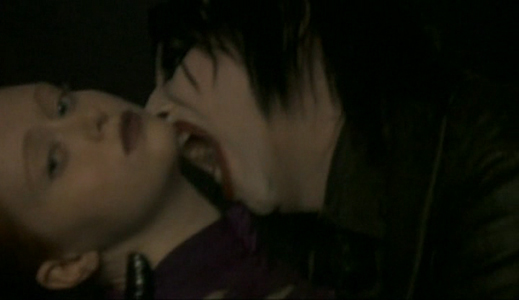 Screen still from the 'Putting Holes In Happiness' music video of Manson depicting the vampiresque nature 'Eat Me, Drink Me' embodies.
Screen still from the 'Putting Holes In Happiness' music video of Manson depicting the vampiresque nature 'Eat Me, Drink Me' embodies.Directly preceding the album's release followed with numerous connections made to Vampires, including the signature goth anthem, "If I Was Your Vampire", and the song "Putting Holes in Happiness" described as "a romantic-misogynistic-cannibal-gothic-vampire ballad.", one can also examine "Eat Me, Drink Me" from a vampiristic perspective, in which the flesh is punctured and sustenance is drawn from the blood of the host, quite literally the life source of their being.
 |
 |
 |
 |
| Subliminal vampiresque night-vision sequences appearing along the video for Putting Holes in Happiness; a subtle way to evoke vampirism without falling into the obviousness of traditional clichés. |
|
 |
|
 |
 |
| Yet another reference to Fritz Lang's M, Peter Lorre and Vampirism at the same time (screen capture from Putting Holes in Happiness). It's noteworthy to mention that the movie was dubbed 'The Black Vampire' in some countries. | |
Manson has always assumed the role of the Antichrist with many previously allusions, stemming from art, the Bible, and various facets of the occult. Since his beginnings Manson has generally been likened as our modern day Dracula, though often in a manner which wouldn't necessarily be as flattering or efficacious. However with his rebirth, so to speak with Eat Me, Drink Me, it is the first incarnation of his art where he has embraced and personified this role fully in overtly embodying imagery which is intentionally "gothic".
Though one can condemn on a surface level and dismiss this new aesthetic as a new marketing ploy, it is however interesting to note that the name Dracula is derivative from the word meaning 'Dragon' or 'Devil', thus adding a bit more efficacy and making this new personification rather apropos.
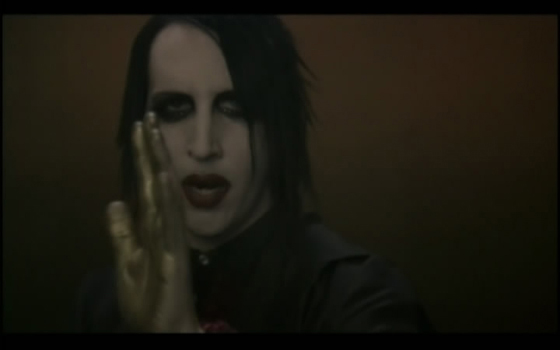 Scene from the 'Putting Holes In Happiness' video showing Manson with a golden hand, evoking the Midas touch and the philosopher's stone.
Scene from the 'Putting Holes In Happiness' video showing Manson with a golden hand, evoking the Midas touch and the philosopher's stone.I met with Jodorowsky in Paris and he read my tarot again. He also identifies with cannibal symbolism and he said to me this record was me trying to be human. It was the opposite of the Christ metaphor where a man became a symbol that people devoured symbolically. I am a symbol that has no human definition that decided to become human by getting married and had no way to define myself. This record became my ascension instead of my fall. He said angels and devils are the same essentially. He told me that this record was the philosopher's stone, which I believe to be true. This is the result of the alchemy that I didn't realize I had to accomplish. This isn't choosing it as a theme; it's living it. You probably need to be blind to these concepts to really accomplish them.'The Red Carpet Grave', Marilyn Manson for MansonUSA.com.
Besides that alchemy Manson says to have accomplished, and the union of opposites he continually depicts, it's interresting to note that this legendary alchemical tool is said to transform base metal into gold. Indeed, if we consider the association between the metal element and the metal music Manson used in the lyrics for Lunchbox, this can also be a statement about his creation accessing to a more refined dimension. Metaphorically, the philosopher's stone is often used to symbolize Love (everything touched by love becomes gold), thus befitting with this other prominent theme of the album.
